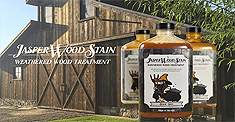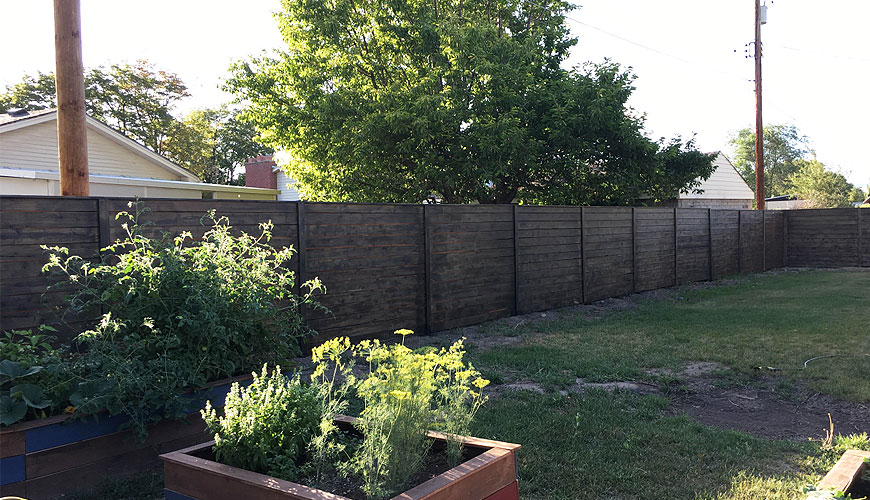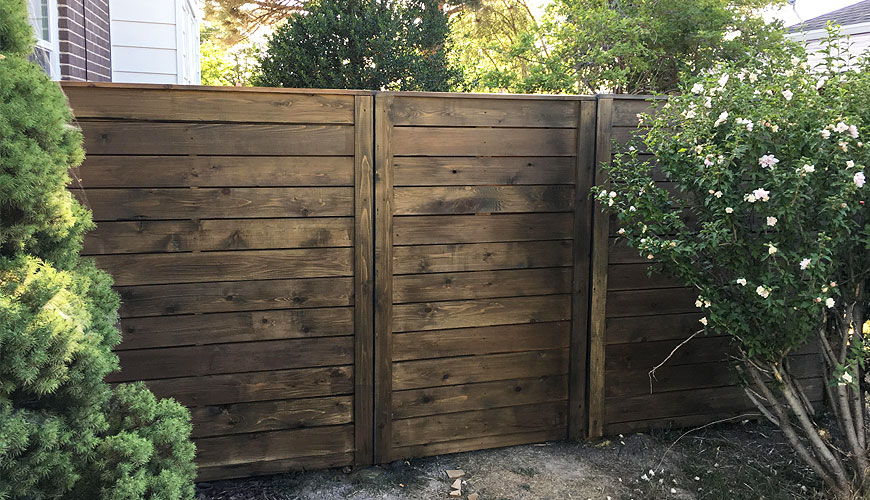Which is Better for Garden Fencing: Cedar or Pine?
Cedar and Pine are among the most versatile options for any timber project on your list. Each comes with unique characteristics that make them an attractive choice for exterior projects like garden fencing. Both are stylish options for fencing but they do have some advantages and drawbacks. So we’ll look at their main differences to help you choose the right timber for your garden fencing.
Color and Grain
Cedar and Pine have beautiful, natural tones that are light on the eyes. Cedar comes with a richer reddish tone and a beautiful tight grain pattern, which makes it a more attractive option for most home builders. It is a warm, rich, and natural-looking wood that develops a beautiful silver patina when left untreated.
Pine on the other hand has a lighter, creamier color ranging from white to yellowish, brown tones. But because Pine must be pressure-treated to make it resistant to elements and other wear and tear, it isn’t the most natural-looking timber you’ll see. Cedar has a natural resistance to moisture and insects so it doesn’t have to be treated the same way.
Cost
Unsurprisingly, cedar costs more than Pine. A 150-foot Cedar fence can cost around $3,000 to $5,000 while pine garden fencing of the same area only costs around $1,500 to $3,000. But the cost of your fencing project still depends on factors such as total square footage, other materials, added features like posts and stairs, and professional labor.
Maintenance Requirements
Cedar has natural oils that make it resistant to rot, insects, and fungal attacks. It is one of the most durable timbers available today, guaranteed to last for several years with very little maintenance.
Meanwhile, Pine has to be treated with various chemicals to protect it from moisture, insects, and other elements that may compromise its durability. Regular maintenance is necessary to keep this timber durable and extend its lifespan. Overall, Cedar requires less maintenance than Pine but may be more expensive in terms of repair costs.
Strength and Durability
Aside from the rich, natural tones that Cedar has, it is also known for its time-tested strength and durability. It is naturally resistant to elements and remains dimensionally stable even when exposed to moisture. It also holds very well in harsh weather conditions. Meaning, it doesn’t readily warp, shrink, or split.
Pine, even when pressure-treated, is more susceptible to warping and splitting. It will start to warp and weather within just a few years without treatment. Generally, Cedar is more naturally capable of keeping its shape for a very long time but Pine has better resistance to soil. It is for this reason that many people prefer to use Pine for fence posts and Cedar for the fence panels.
Moisture Resistance
Cedar is naturally resistant to moisture but it doesn’t cope very well in very wet and humid places. The boards may expand after some time, which can cause problems in the future. Pressure-treated Pine offers better moisture resistance than Cedar. This is why Pine may be a better option for areas with very high amounts of rainfall.
Longevity
Because Cedar is naturally stronger and more durable, it is expected to last longer than Pine. Cedar fences can last between 15 to 30 years even when left untreated, depending on how well you take care of them and the cedar species you’re using. One of the most durable cedar species to consider is Western Red Cedar, which comes with beautiful red, pink, and brown tones.
Pressure-treated Pine can last between 10 to 15 years but the longevity still depends on several factors including the quality of the pressure-treated wood and climate.
Workability, Smell, and Sustainability
Both Cedar and Pine have very good workability. They can be easily worked with hand tools. For Cedar, having knots on the wood may be difficult to work with but that is not always the case. Meanwhile, some species of Pine like Longleaf Pine are rich in resin which can cause problems with sandpaper and clog up saw blades during milling. But generally, both timbers are very easy to work with.
Another distinct characteristic of Cedar is its natural, aromatic smell which you’ll certainly enjoy. It is also a more eco-friendly option than Pine as it’s not treated with chemicals that may taint the soil. If you have value sustainability, Cedar is the option to go for.
Summary of Merits and Flaws of Cedar and Pine
Here’s a quick a summary of the pros and cons of Cedar and Pine garden fencing.
Cedar Garden Fencing Pros
- Beautiful, rich reddish-brown appearance
- Naturally rot-resistant
- More dimensionally stable
- Requires less maintenance
- 100% eco-friendly
- Pleasant, aromatic smell
- Longer lifespan
Cedar Garden Fencing Cons
- More expensive
- Not ideal for humid places
- Less soil-resistant
- Can be hard to obtain
Pine Garden Fencing Pros
- More affordable
- Great soil-resistance
- Ideal for humid places
- Easier to obtain
- Ideal for posts
Pine Garden Fencing Cons
- Less durable
- Lesser dimensional stability
- Requires more maintenance
- Less eco-friendly
- Less natural-look
- Shorter lifespan
So, which is better for garden fencing?
Overall, Cedar is obviously a premium choice for garden fencing. Cedar fences offer a more aesthetic look than pressure-treated Pine and come with a distinct, aromatic smell that you’ll surely enjoy.
Pine is more affordable than Cedar but it’s less durable and requires more maintenance. But because of its high resistance to soil, it is a great option for fence posts.
The choice still depends on your budget, preference, and climate. Using Cedar for fence panels and Pine for fence posts is also an option worth considering.
If you need expert advice on which lumber to use for your fencing project, contact our friendly lumber experts at Rustic Lumber Company and we’ll be happy to help you get started. We offer a variety of high-quality lumbers for different applications. Call us today.








